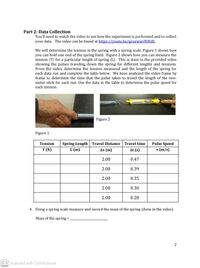
College Physics
11th Edition
ISBN: 9781305952300
Author: Raymond A. Serway, Chris Vuille
Publisher: Cengage Learning
expand_more
expand_more
format_list_bulleted
Concept explainers
Question
https://youtu.be/gozewwrNWdE

Transcribed Image Text:Speed of waves
Name:
Apparatus: Long spring, meter stick, spring scale, stopwatch (or cell phone stopwatch)
Objectives
1. To directly calculate the speed of waves in a stretched spring.
2. To investigate the dependence of wave speed in a spring on its tension.
Part 1: Introduction
In class you learned about propagation of waves in a stretched spring. The speed of waves
(periodic waves or pulses) on a spring depends on the tension and the linear density, u, of
the spring. One way to make direct measurements of wave speed is to create a transverse
pulse in a tight spring of known stretched length and then measure the time taken by that
pulse to move from one end of the spring to the other end. In this experiment we are going
to investigate how the speed of pulses in a given long spring depends on its tension.
1. Predict how the speed of a pulse will change if we stretch the spring more (that is,
we increase the tension T in the spring). Will it increase, decrease, or stay the same?
Explain why you think so.
2. Suggest or outline an experimental procedure to measure the speed of pulses, v, in
the spring. Do this without looking ahead. We just want you to think about how
you could measure wave speed.
3. For the pulses travelling in the spring, is your measurement going to be more
accurate or less accurate if you measure time for longer travel distance? Why?
1
CS Scanned with CamScanner

Transcribed Image Text:Part 2: Data Collection
You'll need to watch the video to see how the experiment is performed and to collect
your data. The video can be found at https://youtu.be/gozewwrNWdE.
We will determine the tension in the spring with a spring scale. Figure 1 shows how
you can hold one end of the spring fixed. Figure 2 shows how you can measure the
tension (T) for a particular length of spring (L). This is done in the provided video
showing the pulses traveling down the spring for different lengths and tensions.
From the video, determine the tension measured and the length of the spring for
each data run and complete the table below. We have analyzed the video frame by
frame to determine the time that the pulse takes to travel the length of the two-
meter stick for each run. Use the data in the table to determine the pulse speed for
each tension.
Figure 2
Figure 1
Spring Length Travel Distance
L (m)
Tension
Travel time
Pulse Speed
T (N)
Ax (m)
At (s)
v (m/s)
2.00
0.47
2.00
0.39
2.00
0.35
2.00
0.30
2.00
0.28
4. Using a spring scale measure and record the mass of the spring (done in the video).
Mass of the spring =
%3|
2
CS Scanned with CamScanner
Expert Solution
This question has been solved!
Explore an expertly crafted, step-by-step solution for a thorough understanding of key concepts.
This is a popular solution
Trending nowThis is a popular solution!
Step by stepSolved in 3 steps

Knowledge Booster
Learn more about
Need a deep-dive on the concept behind this application? Look no further. Learn more about this topic, physics and related others by exploring similar questions and additional content below.Similar questions
- Your help working through this problem will be a greater learning experience than I've had in class this semester. I have so little idea of how to begin this.arrow_forwardHehddndbbddarrow_forward89% CCGC G M C ezto.mheducation.com/ext/map/index.html?_con=con&external_browser%3D0&launchUrl=https%253A%252F%252Fnewconnect.mheducation.com%25 Saved Help Save & 1 Required information CH An apparatus is designed to study insects at an acceleration of magnitude 923 m/s. The apparatus consists of a 4.00-m rod with insect containers at either end. The rod rotates about an axis perpendicular to the rod and at its center. of 2 pok Int FInt where L = 4.00 m. ences How fast does an insect move when it experiences a radial acceleration of 923 m/s? m/sarrow_forward
arrow_back_ios
arrow_forward_ios
Recommended textbooks for you
 College PhysicsPhysicsISBN:9781305952300Author:Raymond A. Serway, Chris VuillePublisher:Cengage Learning
College PhysicsPhysicsISBN:9781305952300Author:Raymond A. Serway, Chris VuillePublisher:Cengage Learning University Physics (14th Edition)PhysicsISBN:9780133969290Author:Hugh D. Young, Roger A. FreedmanPublisher:PEARSON
University Physics (14th Edition)PhysicsISBN:9780133969290Author:Hugh D. Young, Roger A. FreedmanPublisher:PEARSON Introduction To Quantum MechanicsPhysicsISBN:9781107189638Author:Griffiths, David J., Schroeter, Darrell F.Publisher:Cambridge University Press
Introduction To Quantum MechanicsPhysicsISBN:9781107189638Author:Griffiths, David J., Schroeter, Darrell F.Publisher:Cambridge University Press Physics for Scientists and EngineersPhysicsISBN:9781337553278Author:Raymond A. Serway, John W. JewettPublisher:Cengage Learning
Physics for Scientists and EngineersPhysicsISBN:9781337553278Author:Raymond A. Serway, John W. JewettPublisher:Cengage Learning Lecture- Tutorials for Introductory AstronomyPhysicsISBN:9780321820464Author:Edward E. Prather, Tim P. Slater, Jeff P. Adams, Gina BrissendenPublisher:Addison-Wesley
Lecture- Tutorials for Introductory AstronomyPhysicsISBN:9780321820464Author:Edward E. Prather, Tim P. Slater, Jeff P. Adams, Gina BrissendenPublisher:Addison-Wesley College Physics: A Strategic Approach (4th Editio...PhysicsISBN:9780134609034Author:Randall D. Knight (Professor Emeritus), Brian Jones, Stuart FieldPublisher:PEARSON
College Physics: A Strategic Approach (4th Editio...PhysicsISBN:9780134609034Author:Randall D. Knight (Professor Emeritus), Brian Jones, Stuart FieldPublisher:PEARSON

College Physics
Physics
ISBN:9781305952300
Author:Raymond A. Serway, Chris Vuille
Publisher:Cengage Learning

University Physics (14th Edition)
Physics
ISBN:9780133969290
Author:Hugh D. Young, Roger A. Freedman
Publisher:PEARSON

Introduction To Quantum Mechanics
Physics
ISBN:9781107189638
Author:Griffiths, David J., Schroeter, Darrell F.
Publisher:Cambridge University Press

Physics for Scientists and Engineers
Physics
ISBN:9781337553278
Author:Raymond A. Serway, John W. Jewett
Publisher:Cengage Learning

Lecture- Tutorials for Introductory Astronomy
Physics
ISBN:9780321820464
Author:Edward E. Prather, Tim P. Slater, Jeff P. Adams, Gina Brissenden
Publisher:Addison-Wesley

College Physics: A Strategic Approach (4th Editio...
Physics
ISBN:9780134609034
Author:Randall D. Knight (Professor Emeritus), Brian Jones, Stuart Field
Publisher:PEARSON